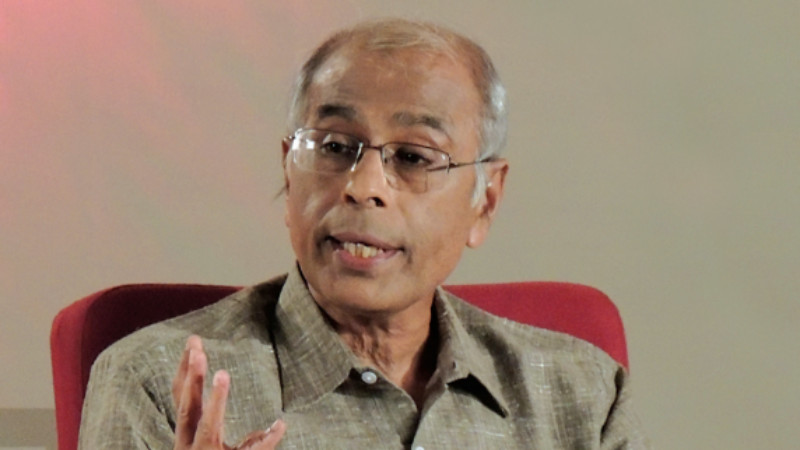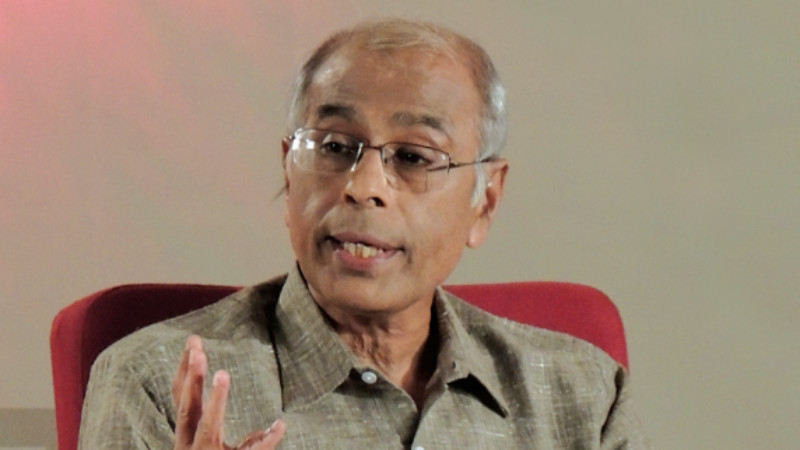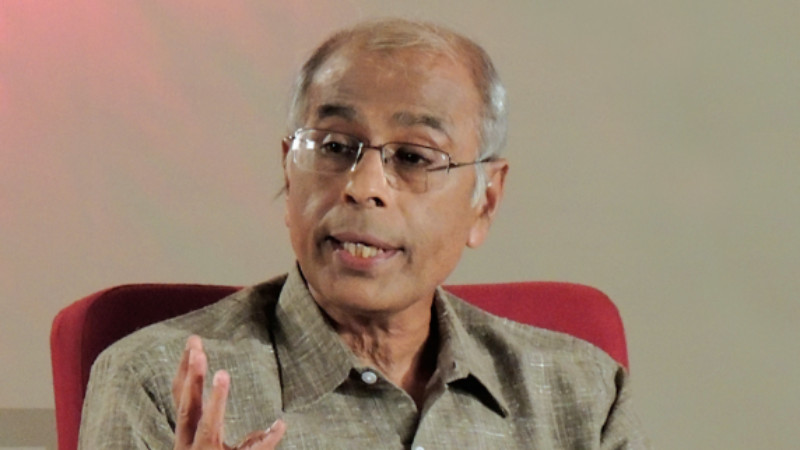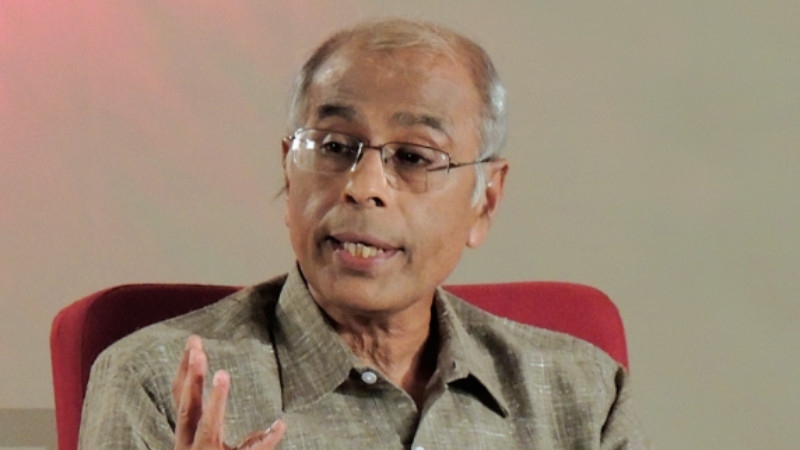On 8th April 2013, in the auditorium of Dr. S. M. Joshi Socialist Foundation (Pune), A 100-minute interview with Narendra Dabholkar was conducted under the title ‘Prashna Tumcha, Uttar Dabholkaranche’ (Dr. Dabholkar Answers Your Questions...) In this interview Dr. Dabholkar answered 25 questions that are most commonly asked of him and the activists of Maharashtra Andhashraddha Nirmulan Samiti (ANS) by people belonging to different faiths, different beliefs, different professions and different corners of Maharashtra. These questions are answered very precisely.
The interview, conducted in April 2013, just four months before his assassination, is available on you tube, published in Marathi as a special issue of Sadhana, and subsequently in booklet format. Thousands of DVD copies of this interview have been distributed across Maharashtra. More than 25 thousand copies of the booklet have been sold.
The verdict of the Dr. Narendra Dabholkar Murder Case was declared yesterday by a special court in Pune. We at Sadhana believe the verdict to be incomplete. But the hope is still alive to continue the judicial battle and seek justice. As a tribute to Dr. Dabholkar’s life’s work, we bring to you this interview. This is the first time that the interview is being published in English for the wider audience in and out of Maharashtra.
Question 1: During the last twenty-five years, Dr. Narendra Dabholkar, Founder Chairman of Maharashtra Andhshraddha Nirmulan Samiti (MANS), was often asked different types of questions by people from various strata of society in all sorts of programmes from different corners of Maharashtra. These questions and their answers are discussed in the book Andhshraddha: Prashnachinha and Poornaviram—Superstitions: Question mark and Full stop—quite extensively. The book is easily available too. We are going to ask Dr. Dabholkar twenty-five questions in this interview not included in that book except two or three. While discussing eradication of superstition, a phrase ‘Scientific Temperament’ is often used. The first question in this context is: What exactly is meant by ‘Scientific Temperament’ and why does ANS (Andhshraddha Nirmulan Samiti) insist on using this phrase extensively?
Answer: ‘Scientific Temperament’ means interpreting the world by adopting a different and unconventional attitude. For the first time. it was Copernicus who told the world that though the sun seems to revolve around the earth, in reality it is the earth that revolves around the sun; this we call the ‘Copernican Revolution.’ Owing to this discovery by Copernicus, the central point of the world’s vision shifted. After that many discoveries were made in the field of science, and gradually the concept of ‘Scientific Temperament’ came into being. In the last century, this attitude became so important that the Indian Constitution included it in the fundamental duties of Indian citizens; it was also included in core components of education as well as value education. This clearly underlines the fact that Scientific Temperament came to the world hardly during the last four or five hundred years, while the history of religion has dominated this country for the last five-six thousand years. Pandit Jawaharlal Nehru put forward the Scientific Temperament in the Parliament in 1953. The Indian Constitution has stated it as follows: ‘It is the duty of every Indian citizen to promote scientific temperament.’ The point to be noted is this: The Indian Constitution has not stated that it is the duty of every Indian citizen to promote religion and spirituality which has a history of five thousand long years; it has insisted that Indian citizens should accept and promote Scientific Temperament. But what exactly does it mean? There are four points to be considered here.
- If the meaning of ‘Scientific Temperament’ is to be stated in one word, it is the cause-and-effect relation. Every act has a cause or reason behind it. It does not have at its back anything like God, fate, fortune, destiny, predestination and providence.
- My intellect can comprehend this reason because it has been often said in our country, ‘You are an O.B.C., you will understand only this much. You are Dalit, you will not understand anything. You are a woman; hence, you have no right to be educated.’
- Reasons behind all the activities in this world cannot be understood. For example, it’s not yet known why cancer affects living beings. But scientific temperament is always modest. It believes that it will continue to search truth endlessly forever. It is never based on the concept of ultimate truth as in religion.
- Today, the most dependable and only way discovered by man to acquire knowledge is ‘Scientific Temperament.’ The sources of knowledge based on mere books and on sheer intellect as well as acquired through a Guru’s blessings—are all rejected today. Hence, acceptance of Scientific Temperament has become a very important aspect of human life. It is a precondition to achieve progress of our country. That is precisely why ANS insists on ‘Scientific Temperament.’
Question 2: You and your activists have always presented a four-point agendy to achieve eradication of superstition. What is that four-point agenda and what is its exact contribution to the eradication of superstition?
Answer: The four-point agenda to eradicate superstition is as follows:
1. To oppose harmful superstitions and rituals which exploit and misguide people
2. To promote and inculcate Scientific Temperament
3. To undertake constructive and, at crucial moments, critical analysis of religion
4. To make concrete efforts to associate ANS with progressive social transformation organisations in the larger context
What does opposing superstitions that exploit people mean? What are these superstitions? One of the answers to this question lies in the law that Government of Maharashtra is going to pass now, and another answer lies in the mantra that one of my younger workers had prepared to answer the question, ‘What is eradication of superstition?’ That mantra is as follows: Black Magic or occult, ‘godmen cult’ (buvabaji), ghosts, bhanamati, good or bad omen, fate, astrology or fortune telling, miracles, chakwa or deception, drushtha lagane (evil eye), mooth marane (evil spell), devi angaat yene (being possessed by a goddess) - these are all full of pretence and hypocrisy. We have given an open challenge to all: ‘We will pay Rs. 21 lakhs, if these are conclusively proved to be real!’ All the titles referred to in this mantra are superstitions, and to combat with them is the first objective of our four-point agenda.
The second objective is to accept and promote the thought of scientific temperament. ANS works at all levels to achieve the same. For example, ANS has organised workshops for teachers on a large scale. About three lakh students have been trained through them. They have also undertaken projects like mobile planetarium.
The third objective is to undertake constructive and critical analysis of religion. I personally feel that there is no other organisation like ANS in Maharashtra which undertakes such constructive criticism. For example, there are about a crore and half Ganesh idols installed generally in Maharashtra every year during the Ganesh festival. The idols are made of plaster of paris and they don’t dissolve in water, but the chemical paints used therein dissolve and pollute the water. This is critical analysis of religion. Women are not allowed to enter on the platform of the Temple at Shani-Shinganapur (Dist. Ahmednagar) and in Mahalaxmi temple at Kolhapur even in the 21st century. Questioning the same is critical analysis of religion. About five to six lakhs of goats are sacrificed in about three to four thousand fairs in Maharashtra. How to stop this slaughter of goats is also critical analysis of religion. When science has made tremendous progress today, why are inter-caste marriages opposed? To undertake such critical analysis of religion through constructive activities is the third objective of ANS.
The fourth objective is to associate ANS with progressive organisations working for social transformation on a large scale. Our movement wouldn’t be successful if we just emphasize eradication of superstition in seclusion and work entirely on our own. We need to associate ourselves with large-scale social transformation and, to achieve this goal, eradication of superstition would be helpful as a complementary activity.
Question 3: You have clarified your view of Scientific Temperament and the four-point agenda of objectives by ANS. However, there are many people who are confused in their mind about faith and superstition. Several people think that faith cannot be superstitious. How exactly do you and ANS distinguish between faith and superstition?
Answer: This is a good question. Some people think that every faith is superstition. Some others say that faith is never superstition. Still others say that faith is different from superstition. And fourth group says that there is a thin and blurred line of differentiation between faith and superstition. All these people are making their comments without defining faith and superstition. For offering an explanation of the two terms, let us refer to three words: conviction, superstition and faith.
If I say, it is my faith that this loudspeaker will reach my voice up to you, you would say in response that, if the electricity supply to this hall is disrupted and alternate electric power is not supplied, then even if you faithfully bow down before the loudspeaker, it will not reach your voice up to us. In this, the cause-and-effect relation is clear. This we call ‘conviction.’
Superstition means the absence of cause-and-effect relation and the impact of exploitation that we have considered sacred owing to our age-old mental slavery. The dreadful aspect of superstition is that even if cause-and-effect relation is clearly visible, people continue to look upon exploitation as sacred owing to their mental slavery. For example, when a daughter—who is a professor of a science subject—comes home and says to her father, “I have fixed my marriage. My would-be husband belongs to another caste.” Her father says, “My girl, what have you done? You have totally spoiled the reputation of our entire family.” But if she says to him, “Daddy, don’t you know that the genome pattern of almost all men is the same?” The father has no answer to it because the concept of mental slavery tells us that some castes are higher and some are lower in status; and this statement is looked upon as sacred. That is why even today inter-caste marriages are vehemently opposed. It means superstition invariably generates exploitation.
Then what is faith? It means a rational power that has become intensely active. Friends, this definition has come from Justice Mahadeo Govind Ranade. The first criterion of faith is ‘intensity’ because all of us are emotional beings. Emotion springs from two-third portion of our midbrain. It means, we are biologically emotional. The second feature of faith is that it is active forever. Faith is always action-oriented. The most significant feature of faith is that it uplifts humane and ethical rationalism. On the contrary, that which downgrades human rationalism is always superstition. For example, a hooligan from my lane is harassing all people. If I decide to fight with him, all will say to me, “Arre, have you gone mad? Don’t you know he has gangsters at his back, has support of rich powerful people, is well-connected with the police, there are leaders at his back and he has liaison with media people? Why are you going against him?” I react saying, “I know all this. But it’s my faith that ultimately truth always triumphs! Or my faith tells me that owing to god’s blessings truth always triumphs ultimately.” I don’t know whether God blesses or not. History does not always show that truth always triumphs. But in order to unify my power to act together so that I can fight with him, I say, “Yes, truth always triumphs ultimately” because my value-based rationalism tells me so. Hence, value-based rationalism, action-orientation and emotionalism are the features of faith. If we are able to understand this properly, the exact difference between faith and superstition will be clearly understood
Question 4: We are able to get some idea about the nature of the role ANS has been playing from the answers to the first three questions. Now we come to the basic question which we all face initially in our lives. It refers to the concept of ghost. What exactly is a ghost? Does a ghost really exist? Generally, these questions do trouble us at some stage in our life. What is your take on this?
Answer: Our view is quite clear: A ghost does not exist anywhere in the world; it is in your or our minds. Many people ask, ‘Are ghosts unreal?’ The answer is, ‘Yes, ghosts are not real. But there is a possibility that what you feel is real. What does this mean? A ghost is created by our fear, delusion or hallucination.
We can understand that a ghost exists due to fear in our mind. Imagine that there is an old ‘wada’ in a dilapidated condition in which smuggling is going on. If a rumour spreads that there are ghosts, it is possible that the activity of smuggling would go on smoothly. Thus, they are able to create a ghost on account of people’s fear of ghosts.
But what does it mean by saying that a ghost exists owing to delusion? Once my friend and I were walking on the road beside a crematorium around 12 o’ clock at midnight. We were away from the crematorium. My friend saw a white figure moving in the air from there to here and vice versa. He was sitting as a pillion rider on my scooter. He didn’t say anything. After some time, I looked in the direction and I too saw the white figure. I said to him, “Arre, did you see it?” He said, “I saw it a little while ago.” When a white figure is moving in the air covering some distance near a crematorium, there are just two possibilities: One, you instantly run away from there increasing your speed; two, go there and see. Therefore, we went near and tried to see. We came to know that on both sides of the crematorium, some low-caste nomadic dombari families were staying in huts. There was a rope fixed to poles on both sides and a dombari girl was practising her trick of walking on the rope. If we had not seen this, we would certainly have believed that a ghost was walking from here to there in the form of a woman in white clothes. This is delusion. In short, it’s delusion or a false belief.
Now what is meant by hallucination? There are two types of psychological disorders. For example, a woman was speaking normally up to yesterday. But suddenly today, her face and voice changed. She began to blink her eyes, started pinching her fingers and began to whirl her body; and the next day she was normal again. In such a case, what is the doubt? That she was caught up by the ghost yesterday and she is set free today; this happens because we don’t know that mind can be sick suddenly and it can recover equally suddenly. The example of the white ghost I have given you earlier was delusion created by our senses. But the hallucination created by the mind is different. There is nothing and yet you see it. There is no one in front, still you feel that a white old hag is standing. Nobody is speaking around, but you feel that someone is giving you a message in your ear; there is no smell around, but you feel that you smell something rotten. All these things are called hallucinations of the mind. Being ignorant of this, we feel that a woman is haunted by a ghost when she starts behaving strangely. Another example: once media people were talking to me on phone in the television programme. At the same time, they were showing photos of ghosts on the TV. Suddenly a telephone call from Delhi got connected and the anchor from there asked, “We have Dr. Dabholkar with us, we are showing him all the photos of ghosts. Tell me, Doctor, what is your opinion?” Then I shouted loudly, “It is a fraud.” For them, it was quite unexpected. My voice was heard by all while the projected photos of ghosts were being projected! The anchor said, “No, no! We are not doing any fraud,” I said. “Hey, you are doing fraud,” The anchor said, “No, no. We have worked hard to collect these photos of ghosts.” I said, “You might have got the photos of ghosts, but did you give them to us for inspection? Where did you get them inspected? How did you get them, did you tell us?” So, friends! It is just said that ghosts exist; at the same time, you take it from me, it is either fear or delusion or hallucination or media fraud.
Question 5: Many people have claimed of having seen a ghost, but they are not able to show it to others. Their discussions centred only around, ‘My friend saw it and showed it to him.’ It is true that nobody has claimed to have shown a ghost to a large group publicly. However, many of us have seen or experienced that some persons are haunted or possessed by a spirit or a goddess entering into their body. What do you say about it?
Answer: Really speaking, I will have to give a lecture for half an hour, if I have to speak on the subject of a goddess entering into a person’s body. But I will explain it here in five minutes. There is a clock kept in front of me. Hence, I’m carefully monitoring my words and the time I have spoken in giving each answer. ‘A spirit entering into a body’ is of four types: First is pretence, second is hypnosis, third is culturally sanctioned behaviour and fourth is incidental break down of mind. You will not understand it this way, hence I will explain it in simpler terms.
There are two parts of our mind. One is outer mind; the other is inner mind. Now it’s my outer mind that is speaking to your outer mind; but something is simultaneously going on in your inner mind! And at the same time, something else is going on in my inner mind as well.
Our inner mind is like a warehouse. Just as a huge warehouse is stuffed with a lot of goods, we stuff our inner mind with all our sorrow, suffering, pain and despair we have had in our life. Let me take a simple example. All the men and women sitting here have to answer this question honestly: Did you get the spouse in your life that you had visualised before marriage? I saw a smile lurking on your face. I have got my answer. Everyone wishes to have a prince or a princess. However, in real life you have to marry a Pami, Yami or Thami. Then the question arises, what happens to that prince or princess? You throw him/her into the warehouse of your inner mind and say, ‘This is not possible in this life, let me see if I am lucky in my next life.’ However, the warehouse remains neat and tidy, until it accommodates manageable goods. If more goods keep coming in again and again, they go out from windows or from the net near the roof; then the warehouse becomes disorderly. Or, even if the warehouse is kept neat and tidy, and the keeper gets drunk or goes to sleep, then what happens? At that time, what happens to the warehouse, the same happens to the human mind. Hence, if your outer mind and your inner mind are linked well and are associated coherently, it means your mind is healthy.
Then, what happens when a woman or a man is possessed? Firstly, it is pretence or hypocrisy. We can see so many examples of this around us. You can examine them, but I don’t wish to take you on the path of hypocrisy today because it is a point to be taken up by the movement. We are discussing it here rationally.
The second is hypnosis. When everyone from amongst you goes into hypnosis after accepting instructions on your own, at that time, it can be shown that your family deity enters into your body. If you just accept and follow my instructions for ten minutes, you will see your deity almost immediately and you will fall prostrate before the image of the deity. I can video shoot it and show it you because your mind is in a state of hypnosis.
The third is ‘culturally sanctioned behaviour.’ In the towns from rural areas, some persons are possessed by spirits in fairs and rural festivals. All that is hypnosis; but it is associated with culturally sanctioned behaviour of some definite traditions. The most significant example of body possession is the occasional break down of mind! This is related more to the movement of ANS. What does it mean? Have you ever thought about the fact: Why do we find more women being possessed in our country? Are women popular in the kingdom of goddesses? Or have the goddesses decided that they wish to enter only into the bodies of women? Just listen! A simple reason for it is this. If a dam is full of water up to its maximum capacity and it has no more capacity to store more water, the gates of the dam have to be opened; or else the pressure of water would increase and the dam would burst. The social and cultural situation in this country is such that the dam of sorrow in the mind of a woman is filled quickly. If it were not so, the woman, who is God’s Magum Opus, wouldn’t have to work to stop the illegal killing of the foetus. It means, if the dam of sorrow in a woman’s mind is full, the doors of her inner mind are naturally opened and she enters into some other role. Please bear in mind that this is a real drama. To bring about the catharsis of her suffering, a woman accepts that role at the level of her unconscious mind. That is why, we always tell our workers that a woman’s path is wrong, but it is imposed on her by her ignorance or by the overpowering society around her.
Hence, the main principle that ANS workers should keep in mind is that there should be more compassion than anger and more affection than ridicule in their work while dealing with such cases. If you have that awareness in mind, you would be able to speak with more sympathy and more appropriate action in the right direction.
Read Part 2 of the Interview here
- Dr. Narendra Dabholkar
(Founder Andhashraddha Nirmulan Samiti, Former Editor of Sadhana Weekly)
Interviewer: Vinod Shirsath (Editor, Sadhana Weekly)
Translated by Vilas Salunke
vilasalunke@gmail.com
Tags: prashna tumcha dabholkar narendra dabholkar dr dabholkar interview ans andhshraddha nirmulan Load More Tags

































Add Comment